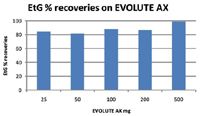Extraction of Ethyl Glucuronide (EtG) from Urine Using EVOLUTE AX for LC–MS-MS Analysis
New efficient, effective, and sensitive sample preparation application for the extraction of ethyl glucuronide from human urine at significantly low levels using EVOLUTE AX; a resin-based mixed-mode sorbent with an optimised combination of nonpolar (hydrophobic), polar (hydrophilic), and strong anion exchange interactions.
Lee Williams, Rhys Jones, Helen Lodder, Steve Jordan, Claire Desbrow, and Gary Dowthwaite, Biotage GB Limited
Ethyl glucuronide (EtG) is an ethanol metabolite formed by the glucuronidation of the parent molecule. The presence of EtG in urine is a useful and sensitive bio-marker of alcohol intake in forensic toxicology. EtG can be detected at very low levels and being a metabolite it is useful in distinguishing between ingested ethanol and that which is adsorbed through the skin from ethanol containing products such as alcohol based hand washes. Rapid and reliable methods with robust extraction protocols are essential for analysis and quantitation of EtG from various matrices.
Extraction Conditions
This application note outlines the procedure using the 25 mg 96-well plate format (part #603-0025-P01) but other formats are available, method parameters and dilution factors have been optimized to maximize recoveries and minimize ion suppression.
Sample: urine (50 μL) spiked at 500 ng/mL with EtG.
Sample pre-treatment: urine (50 μL) in acetonitrile (950 μL).
Plate conditioning: methanol (1 mL)
Plate equilibration 1: water (1 mL)
Column equilibration 2: acetonitrile (1 mL)
Sample loading: pre-treated sample (1 mL)
Interference elution 1: water (1 mL)
Interference elution 2: acetonitrile (1 mL)
Analyte elution: acetonitrile:water:formic acid, (1 mL, 95:4:1, v/v)
Post extraction: evaporate to dryness and reconstitute with water/methanol (200 μL, 80:20, v/v) for LC–MS-MS analysis.
The extracted samples were then run on a Waters Acquity UPLC (Waters Assoc., Milford, Massachusetts) with an Acquity UPLC BEH C18 column (1.7 μm, 50 × 2.1 mm id) (Waters Assoc.) at 40 °C. Mobile phase was isocratic, 0.1% (v/v) formic acid aq/methanol (80:20, v/v) at a flow rate of 0.5 mL/min. The detector was a Premier XE triple quadrupole mass spectrometer (Waters Assoc., Manchester, UK) equipped with an electrospray interface for mass analysis. Negative ions were acquired in the multiple reaction monitoring mode (MRM); 21 > 84.9 (quantifier), 221.0 > 74.9 (qualifier).
Results
As demonstrated in Figure 1 recoveries over 80% with RSDs below 10% were achieved across the range of EVOLUTE AX formats and sample volumes using this application.

Figure 1: EtG extraction recoveries from urine using EVOLUTE AX.
Conclusions
The method demonstrates robust and effective extraction of EtG not only using a 25 mg 96 well-plate but also the optimization is scalable for sample volumes ranging from 50 μL up to 1 mL across format changes from plate to column. As the sample volume increases it is in fact easier to obtain higher recovery rates of EtG, possibly because of the lack of a concentration step.
References
(1) L. Williams, et. al. Extraction of Ethyl glucuronide (EtG) from urine using EVOLUTE AX. Application Note AN 705. (available from www.biotage.com).

Biotage, LLC
10430 Harris Oarks Blvd., Suite C., Charlotte, NC 28269
Website: www.biotage.com
Email: product_info@biotage.com

SEC-MALS of Antibody Therapeutics—A Robust Method for In-Depth Sample Characterization
June 1st 2022Monoclonal antibodies (mAbs) are effective therapeutics for cancers, auto-immune diseases, viral infections, and other diseases. Recent developments in antibody therapeutics aim to add more specific binding regions (bi- and multi-specificity) to increase their effectiveness and/or to downsize the molecule to the specific binding regions (for example, scFv or Fab fragment) to achieve better penetration of the tissue. As the molecule gets more complex, the possible high and low molecular weight (H/LMW) impurities become more complex, too. In order to accurately analyze the various species, more advanced detection than ultraviolet (UV) is required to characterize a mAb sample.

.png&w=3840&q=75)

.png&w=3840&q=75)



.png&w=3840&q=75)



.png&w=3840&q=75)














